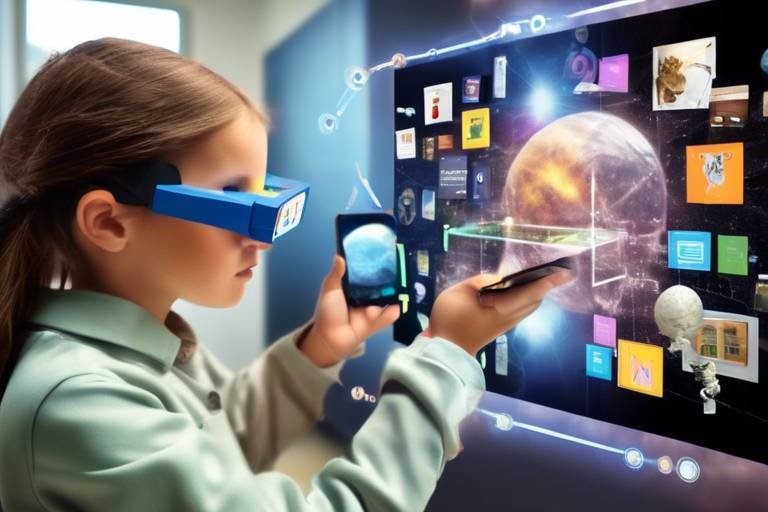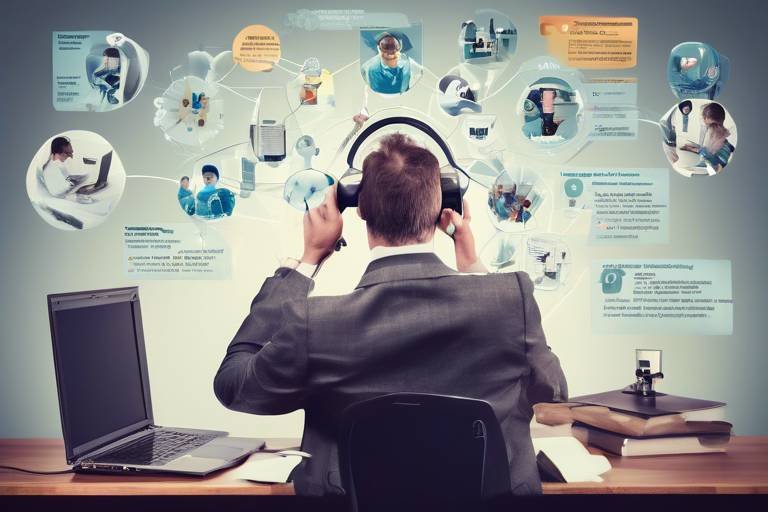How Augmented Reality is Used in STEM Education
In recent years, augmented reality (AR) has emerged as a powerful tool in the realm of education, particularly in the fields of Science, Technology, Engineering, and Mathematics (STEM). Imagine stepping into a classroom where complex scientific concepts come to life right before your eyes! AR bridges the gap between theoretical knowledge and practical application, making learning not just informative but also exciting. With AR, students can visualize intricate processes, conduct virtual experiments, and interact with 3D models, all of which transform the traditional learning environment into a vibrant and engaging space.
One of the most astonishing aspects of AR in education is its ability to foster active participation. Students who may have once been passive recipients of information are now able to immerse themselves in their learning experiences. For instance, instead of merely reading about the solar system, students can explore it firsthand, manipulating celestial bodies and observing their movements in real-time. This kind of engagement is crucial in STEM education, where understanding complex systems and processes is essential.
Furthermore, AR enhances collaborative learning. When students work together on AR projects, they not only share knowledge but also develop critical teamwork skills. Imagine a group of students collaborating on a virtual chemistry experiment, each taking on different roles and responsibilities. This not only deepens their understanding of the subject matter but also prepares them for real-world scenarios where collaboration is key.
As we delve deeper into the applications of AR in STEM education, it becomes clear that this technology is not just a passing trend. It has the potential to revolutionize how students learn and interact with scientific concepts. From biology to physics, AR is paving the way for a more interactive and immersive educational experience.
Augmented reality offers numerous advantages in STEM education, including increased engagement, improved retention of information, and the ability to visualize complex concepts, making learning more interactive and effective. With AR, students can experience a level of engagement that traditional teaching methods often fail to achieve. Imagine a biology student being able to dissect a virtual frog without the ethical concerns associated with real dissections; this not only makes learning more accessible but also enhances their understanding of anatomy.
Moreover, AR can significantly improve retention rates. Studies have shown that when students are actively involved in their learning, they tend to remember information better. This is where the power of AR shines. By allowing students to visualize and manipulate information, they are more likely to retain what they have learned. This is crucial in STEM fields, where foundational knowledge is essential for more advanced concepts.
AR is revolutionizing science education by providing immersive experiences that allow students to explore biological systems, chemical reactions, and astronomical phenomena, enhancing their understanding and curiosity about the natural world. For example, AR applications can simulate chemical reactions, allowing students to observe the effects of changing variables in real-time without any risk. This level of interaction not only deepens their understanding but also sparks their curiosity, encouraging them to explore further.
In biology, AR applications enable students to dissect virtual organisms, observe cellular processes, and interact with 3D models, fostering a deeper comprehension of intricate biological structures and functions. With tools like virtual dissection software, students can explore anatomy in a way that is both ethical and educational.
Virtual dissection tools allow students to explore anatomy without the ethical concerns of traditional dissection, promoting a hands-on learning experience while preserving the integrity of living organisms. Students can manipulate virtual organs, observe their functions, and even simulate diseases, providing a comprehensive understanding of biological systems.
3D cellular models provide an interactive way for students to study cells, helping them visualize and manipulate structures, which enhances their grasp of cellular biology and its complexities. By interacting with these models, students can see how different components of a cell work together, making abstract concepts much more tangible.
In physics, AR tools facilitate the visualization of abstract concepts such as forces, motion, and energy, enabling students to conduct virtual experiments and better understand fundamental principles. Imagine a physics student being able to visualize the trajectory of a projectile in real-time, adjusting variables like angle and velocity to see their effects instantly. This hands-on approach not only makes learning fun but also reinforces key concepts.
Despite its benefits, the implementation of AR in education faces challenges, including technological limitations, the need for teacher training, and the potential for distraction in the classroom environment. For instance, not all schools have access to the necessary technology, which can create disparities in learning opportunities.
Technological barriers, such as the availability of devices and internet access, can hinder the effective use of AR in classrooms, limiting its reach and impact on students' learning experiences. Schools must invest in the right infrastructure to ensure that all students can benefit from these innovative tools.
Proper training for educators is essential to maximize the potential of AR in teaching, as teachers must be equipped with the skills to integrate AR effectively into their lesson plans. Without adequate training, the full benefits of AR may go unrealized, leaving both teachers and students frustrated.
The future of AR in STEM education looks promising, with advancements in technology and increasing adoption in classrooms, paving the way for more innovative teaching methods and enhanced student learning experiences. As AR technology continues to evolve, we can expect even more sophisticated applications that will further enrich the educational landscape.
- What is augmented reality? Augmented reality (AR) is a technology that overlays digital information, such as images and sounds, onto the real world, enhancing the user’s experience.
- How does AR benefit STEM education? AR increases engagement, improves retention of information, and allows for the visualization of complex concepts, making learning more interactive and effective.
- What are some applications of AR in science education? AR can be used for virtual dissections, 3D cellular models, and simulations of chemical reactions, among other applications.
- What challenges does AR face in education? Challenges include technological barriers, the need for teacher training, and potential distractions in the classroom environment.

The Benefits of Augmented Reality in STEM
Augmented reality (AR) is not just a buzzword; it’s a game changer in the world of education, especially in STEM (Science, Technology, Engineering, and Mathematics). Imagine stepping into a classroom where the walls dissolve, and you find yourself exploring the human body or launching rockets into space—all from the comfort of your seat! This is the magic of AR, and it comes with a plethora of benefits that transform traditional learning into an interactive adventure.
One of the most compelling advantages of AR in STEM education is the increased engagement it fosters among students. Traditional teaching methods often fall short in capturing the attention of today's tech-savvy learners. With AR, lessons become immersive experiences that captivate students' imaginations. They no longer passively receive information; instead, they actively participate in their learning journey. For instance, when students can visualize complex scientific phenomena, they’re more likely to grasp and retain the information presented.
Moreover, AR enhances the retention of information. Research shows that students remember information better when they can see and interact with 3D models. For example, a student learning about the solar system can manipulate a 3D model of planets, which deepens their understanding of planetary motion and scale. This hands-on approach not only makes learning fun but also cements knowledge in a way that traditional textbooks simply cannot.
Another significant benefit is the ability to visualize complex concepts. Many STEM subjects involve intricate theories and abstract ideas that can be challenging to comprehend. AR bridges this gap by transforming these concepts into visual representations that students can explore. For instance, in chemistry, students can observe molecular structures and chemical reactions in real-time, making the subject more tangible and less intimidating.
To illustrate these benefits further, consider the following table that summarizes the key advantages of AR in STEM education:
| Benefit | Description |
|---|---|
| Increased Engagement | AR captures students' attention and encourages active participation. |
| Improved Retention | Students remember information better through interactive experiences. |
| Enhanced Visualization | Complex concepts become easier to understand through visual representation. |
| Real-World Applications | Students can see the practical applications of their learning in real-time. |
In conclusion, the integration of augmented reality in STEM education is paving the way for a more engaging, interactive, and effective learning environment. As educators embrace these technologies, they unlock the potential for students to explore, discover, and innovate like never before. The classroom of the future is here, and it’s bursting with possibilities!
- What is augmented reality?
Augmented reality is a technology that overlays digital information—such as images, sounds, and other data—onto the real world, enhancing the user's perception of their environment.
- How does AR improve learning in STEM?
AR enhances learning by providing interactive, visual experiences that help students understand complex concepts better than traditional methods.
- Are there any challenges to using AR in education?
Yes, challenges include technological barriers, the need for teacher training, and potential distractions in the classroom.
- What subjects can benefit from AR?
AR can be applied in various subjects, including biology, chemistry, physics, and engineering, making learning more engaging across the board.

Applications of AR in Science Education
Augmented Reality (AR) is not just a buzzword; it’s a game-changer in the landscape of science education. Imagine walking into a classroom where the walls come alive with interactive visuals, allowing students to explore the universe, dive into the ocean's depths, or even venture inside the human body. This is the transformative power of AR, making learning not only more engaging but also significantly more effective. AR applications bring abstract scientific concepts to life, turning traditional lectures into immersive experiences that captivate students' imaginations.
One of the most exciting aspects of AR in science education is its ability to enhance curiosity and understanding. For instance, when students can manipulate 3D models of molecules or visualize the solar system in real-time, they are more likely to grasp complex ideas. This technology allows learners to interact with content dynamically, fostering a deeper connection with the material. As students rotate, zoom, and explore, they develop a more profound understanding of the subject matter, which traditional textbooks simply cannot provide.
In the realm of biology, AR applications are particularly groundbreaking. Students can engage with virtual dissections, which not only eliminate ethical concerns associated with animal dissection but also provide a detailed view of anatomical structures. Imagine a student being able to explore a heart's anatomy from every angle without any of the mess or moral dilemmas of traditional methods. This hands-on approach encourages exploration and inquiry, making it easier for students to retain information.
Similarly, in chemistry, AR can transform how students learn about chemical reactions. By visualizing molecules and their interactions in a 3D space, learners can see how substances combine and react in real-time. This not only demystifies the process but also sparks interest in the subject. For physics, AR tools allow students to visualize forces and motion dynamically. Imagine a student using an AR app to see how gravity affects different objects; they can manipulate variables and see the results instantly. This kind of interactive learning is invaluable.
The applications of AR extend beyond just individual subjects; they encourage interdisciplinary learning as well. For example, a project that combines biology, chemistry, and physics through AR can help students understand how these fields interconnect in real-world scenarios. This holistic approach not only enhances learning but also prepares students for future challenges in STEM fields.
As we look to the future, the integration of AR in science education is poised to expand. With continuous advancements in technology, we can expect even more sophisticated applications that will further enrich the learning experience. Schools that embrace this technology can provide students with opportunities to develop essential skills in a rapidly evolving world.
Q: How does AR improve student engagement in science education?
A: AR captivates students by making learning interactive and immersive, allowing them to visualize and manipulate complex scientific concepts in real-time.
Q: Are there any ethical concerns with using AR in biology?
A: AR offers a solution to ethical concerns by providing virtual dissections, allowing students to study anatomy without harming living organisms.
Q: What subjects can benefit from AR technology?
A: AR technology can enhance learning in various subjects, including biology, chemistry, physics, and even mathematics, by providing interactive and engaging experiences.
Q: What are some challenges of implementing AR in classrooms?
A: Challenges include technological limitations, the need for teacher training, and potential distractions in the classroom environment.

AR in Biology Classrooms
In the realm of biology education, augmented reality (AR) is truly a game-changer. Imagine stepping into a virtual world where you can dissect a frog without the ethical dilemmas of traditional methods or explore the intricate structures of a cell in stunning 3D. AR technology makes this possible, allowing students to engage with biological concepts in ways that were once confined to textbooks. By using AR, students can interact with virtual organisms, observe cellular processes in real-time, and manipulate 3D models that represent complex biological systems.
One of the standout features of AR in biology classrooms is the ability to foster a deeper understanding of intricate biological structures and functions. For instance, when students are presented with a 3D model of a human heart, they can rotate it, zoom in on specific parts, and even simulate blood flow through the chambers. This hands-on approach makes the learning experience not only more engaging but also enhances retention of information. Students are more likely to remember what they learned when they can visualize and interact with the material.
Moreover, AR tools are designed to cater to various learning styles. Some students are visual learners, while others benefit from kinesthetic experiences. AR bridges these gaps by providing an immersive learning environment that accommodates different preferences. For example, a student struggling to grasp the concept of photosynthesis can use an AR application to see how sunlight, water, and carbon dioxide interact within a plant, making the process tangible and easier to comprehend.
One of the most significant advancements in AR for biology education is the development of virtual dissection tools. These applications allow students to explore anatomy without the ethical concerns associated with traditional dissection methods. With virtual dissections, students can dissect a variety of organisms, from frogs to pigs, all while preserving the integrity of living creatures. This not only promotes a hands-on learning experience but also encourages students to explore the subject matter in a stress-free environment.
Another remarkable application of AR in biology classrooms is the use of 3D cellular models. These models provide an interactive way for students to study cells, helping them visualize and manipulate structures that are otherwise too small to see. Imagine being able to explore a cell membrane and understand how substances move in and out of the cell, or examining the intricacies of mitochondria and their role in energy production. Such experiences not only enhance students' grasp of cellular biology but also spark their curiosity, encouraging them to delve deeper into the subject.
In conclusion, the integration of AR in biology classrooms is paving the way for a more engaging and effective learning experience. By allowing students to interact with complex biological systems, AR not only enhances understanding but also fosters a love for science. As technology continues to advance, the possibilities for AR in education are limitless, and the future looks bright for students eager to explore the wonders of biology.
- What is augmented reality (AR) in education?
AR in education refers to the use of digital information layered over the real world, enhancing the learning experience by providing interactive and immersive content. - How does AR benefit biology education?
AR benefits biology education by allowing students to visualize complex concepts, interact with virtual organisms, and conduct virtual dissections, making learning more engaging and effective. - Are there any ethical concerns with using AR in dissection?
No, AR eliminates the ethical concerns associated with traditional dissections, as it allows students to explore anatomy without harming living organisms.

Virtual Dissection Tools
Virtual dissection tools are transforming the way students engage with anatomy and biology. Imagine being able to explore the intricate structures of a frog, a pig, or even a human body without the ethical dilemmas and environmental concerns that come with traditional dissection methods. These innovative tools provide a hands-on learning experience that is not only more ethical but also more interactive and engaging for students. By leveraging augmented reality, these tools enable learners to manipulate 3D models of organisms, allowing them to peel back layers and examine internal organs in a way that feels almost like a video game.
One of the most exciting aspects of virtual dissection tools is their ability to cater to various learning styles. Some students thrive on visual aids, while others benefit from tactile experiences. With AR, students can visualize anatomy in three dimensions, rotate models, and even simulate physiological processes. This multi-sensory approach can significantly enhance understanding and retention of complex biological concepts. For instance, when students can see how blood circulates through the heart or how muscles contract in real-time, they are more likely to grasp these intricate ideas.
Moreover, virtual dissection tools often come equipped with interactive features that allow students to test their knowledge as they explore. For example, they might be prompted to identify various organs or predict the outcomes of certain physiological changes. This immediate feedback not only reinforces learning but also encourages critical thinking and problem-solving skills. Imagine a student being able to dissect a virtual heart and then being quizzed on its parts right after. This instant reinforcement is invaluable.
However, it's essential to recognize that while virtual dissection tools offer numerous advantages, they are not without their challenges. Schools need to ensure they have the necessary technology and internet access to facilitate these tools effectively. Furthermore, teachers must be adequately trained to integrate these resources into their curriculum. The potential for distraction is also a concern; students might be more focused on the technology than on the learning objectives. Nevertheless, with proper implementation and support, virtual dissection tools can revolutionize the way biology is taught, making it more accessible and engaging for all students.
- What are virtual dissection tools?
Virtual dissection tools are software applications that allow students to explore and interact with 3D models of organisms, providing an alternative to traditional dissection methods. - Are virtual dissections as effective as real dissections?
Many studies suggest that virtual dissections can be just as effective, if not more so, in helping students understand anatomy and physiology, especially when combined with other learning methods. - Can virtual dissection tools be used for all age groups?
Yes, virtual dissection tools can be tailored to suit various educational levels, from elementary school to advanced biology courses in high school and college. - Do virtual dissection tools require special equipment?
While many tools can be accessed via standard computers or tablets, some may benefit from augmented reality devices for a more immersive experience.

3D Cellular Models
Imagine walking into a classroom where the walls come alive with the intricate details of a cell. are revolutionizing the way students understand biology by providing an interactive experience that traditional textbooks simply can't match. These models allow students to explore the various components of a cell—such as the nucleus, mitochondria, and ribosomes—in a three-dimensional space. This not only makes the learning process more engaging but also enhances comprehension by allowing students to visualize and manipulate cellular structures.
One of the most exciting aspects of 3D cellular models is their ability to illustrate complex biological processes. For instance, students can witness how proteins are synthesized or how cellular respiration occurs, all while interacting with the model. This kind of immersive learning experience fosters a deeper understanding of cellular functions and encourages curiosity. When students can see how the parts of a cell work together in real time, it becomes much easier to grasp concepts that might otherwise seem abstract.
Moreover, the use of 3D models can cater to different learning styles. Visual learners benefit from the graphical representation of cells, while kinesthetic learners can engage with the models through touch and manipulation. This multi-faceted approach to learning ensures that all students have the opportunity to connect with the material in a way that resonates with them personally.
Here are some key advantages of utilizing 3D cellular models in the classroom:
- Enhanced Visualization: Students can rotate, zoom in, and examine cellular structures from various angles, leading to a more comprehensive understanding.
- Interactive Learning: Engaging with the model allows students to conduct experiments and make observations that would be impossible with static images.
- Increased Retention: The hands-on experience helps solidify knowledge, making it easier for students to remember complex information.
In conclusion, 3D cellular models are not just tools; they are gateways to a deeper understanding of biology. As technology continues to evolve, the potential for these models to enhance STEM education becomes even more exciting. Students are not merely learning about cells; they are experiencing them, which is a powerful way to foster a love for science and a desire to explore the natural world further.
Q1: What are 3D cellular models?
A1: 3D cellular models are interactive representations of cells that allow students to explore and manipulate cellular structures in a three-dimensional space.
Q2: How do 3D cellular models enhance learning?
A2: They provide a visual and tactile experience that helps students better understand complex biological processes and structures, catering to various learning styles.
Q3: Are 3D cellular models suitable for all educational levels?
A3: Yes, they can be adapted for different educational levels, from elementary school to advanced university courses, making them versatile teaching tools.
Q4: Can 3D cellular models be used in remote learning?
A4: Absolutely! Many 3D models are available in digital formats that can be accessed online, making them suitable for remote or hybrid learning environments.

AR in Physics Education
Augmented Reality (AR) is making waves in the field of physics education, transforming how students grasp complex concepts that have traditionally been challenging to visualize. Imagine being able to see the forces acting on a moving object in real-time or to manipulate the variables of an experiment without the constraints of a physical lab. This is not just a fantasy; it’s the reality that AR brings to the classroom.
One of the most significant advantages of AR in physics is its ability to visualize abstract concepts. For instance, students can interact with 3D models of forces and motion, allowing them to see how different factors affect an object's trajectory. Whether it's understanding the principles of gravity or exploring the intricacies of Newton's laws, AR provides an engaging platform that enhances comprehension.
Moreover, AR enables students to conduct virtual experiments that would otherwise be impossible or impractical in a traditional setting. Imagine a student being able to simulate a roller coaster ride to study the forces at play, adjusting the height and speed to observe how these changes impact the ride's dynamics. This hands-on approach not only makes learning more enjoyable but also fosters a deeper understanding of fundamental physics principles.
In addition to enhancing engagement, AR can also cater to different learning styles. Some students may find it easier to grasp concepts through visual aids, while others may benefit from interactive simulations. By providing a multi-faceted learning experience, AR helps to ensure that all students can connect with the material in a way that resonates with them.
However, it’s important to note that the integration of AR into physics education is not without its challenges. For instance, educators need to ensure they have access to the necessary technology, and they must also receive proper training to effectively implement these tools in their teaching. Despite these hurdles, the potential benefits of AR in creating a more dynamic and engaging physics curriculum are undeniable.
| Benefits of AR in Physics Education | Examples |
|---|---|
| Enhanced Visualization | 3D models of forces, motion, and energy |
| Interactive Learning | Virtual experiments and simulations |
| Accommodating Different Learning Styles | Visual aids and hands-on activities |
As we look to the future, the integration of AR in physics education promises to revolutionize how students learn and interact with the subject. By embracing this technology, educators can create a more immersive and effective learning environment that not only captivates students but also prepares them for a future where understanding physics is more critical than ever.
- What is Augmented Reality? Augmented Reality (AR) is a technology that overlays digital information, such as images and sounds, onto the real world, enhancing the user's perception of their environment.
- How does AR benefit physics education? AR benefits physics education by providing interactive and visual experiences that help students better understand complex concepts and conduct virtual experiments.
- Are there any challenges in implementing AR in the classroom? Yes, challenges include technological limitations, the need for proper teacher training, and ensuring that students remain focused and engaged without distractions.

Challenges of Implementing AR in Education
While the benefits of Augmented Reality (AR) in STEM education are compelling, the road to effective implementation is not without its bumps. One of the most significant challenges is the technological barriers that many schools face. Not every classroom is equipped with the latest devices or reliable internet access, which can severely limit the reach of AR technologies. Imagine a classroom where half the students are unable to participate in an interactive AR lesson simply because their devices are outdated or non-existent. This digital divide can create disparities in learning opportunities, leaving some students at a disadvantage.
Another hurdle is the need for teacher training. Educators are the backbone of any learning environment, and without proper training, even the best AR tools can fall flat. Teachers must not only understand how to use AR technology but also how to integrate it seamlessly into their lesson plans. They need to be equipped with the skills to navigate both the technology and the educational content effectively. Think of it like a chef who has all the best ingredients but lacks the recipe; without the right training, the potential of AR can go untapped.
Moreover, there’s the potential for distraction in the classroom. With the allure of interactive technology, students can easily become sidetracked. Instead of focusing on the lesson, they might find themselves more interested in the flashy graphics or the gaming aspects of AR applications. To combat this, educators need to establish clear guidelines and objectives for AR use in the classroom, ensuring that the technology serves as a tool for learning rather than a source of distraction.
In summary, while the challenges of implementing AR in education are significant, they are not insurmountable. By addressing technological limitations, investing in teacher training, and creating structured learning environments, schools can harness the full potential of AR. The goal is to create a balanced approach where technology enhances learning without overshadowing it.
- What are the main benefits of using AR in education? AR enhances engagement, improves information retention, and allows for a more interactive learning experience.
- How can teachers be trained to use AR effectively? Professional development workshops and hands-on training sessions can equip teachers with the necessary skills to integrate AR into their curriculum.
- What technological barriers exist for AR implementation? Limited access to devices and reliable internet connections can hinder the use of AR in classrooms.
- Can AR be distracting for students? Yes, without proper guidelines, students may become distracted by the technology itself rather than focusing on the educational content.

Technological Barriers
When we talk about augmented reality (AR) in education, it's easy to get excited about the possibilities. However, the reality is that there are significant that can hinder its implementation in classrooms. For starters, not all schools have access to the necessary devices, such as tablets or AR glasses, which can create a disparity in learning opportunities. Imagine a classroom where some students are exploring the universe through AR while others are stuck with outdated textbooks—it's a recipe for inequality!
Moreover, internet access plays a crucial role in the effectiveness of AR applications. In many areas, especially rural or underfunded schools, reliable internet connectivity is still a dream. Without a stable connection, the immersive experiences that AR promises can quickly turn into frustrating failures. Picture trying to watch a live stream of a rocket launch only to have it buffer continuously; the excitement fizzles out, and so does the learning opportunity.
Another factor to consider is the cost of technology. Implementing AR in education isn't just about having the right devices; it also involves purchasing software and applications that can be quite expensive. Schools often operate on tight budgets, and allocating funds for AR can be a daunting task. To put it into perspective, here’s a simple table showing the average costs associated with AR implementation:
| Item | Average Cost |
|---|---|
| AR Software Licenses | $100 - $500 per class |
| AR Devices (Tablets/Glasses) | $300 - $1,500 each |
| Internet Setup and Maintenance | $50 - $200 per month |
In addition to these barriers, teacher training is another critical aspect that often gets overlooked. Even if schools manage to provide the necessary technology, educators need proper training to utilize AR effectively. Without this training, teachers may feel overwhelmed and unsure of how to integrate AR into their lesson plans, which can lead to frustration and a lack of enthusiasm for the technology among students.
Lastly, it's essential to recognize that while AR can enhance learning, it can also be a source of distraction. Students might find themselves more engaged with the technology than the subject matter, leading to a scenario where the tool overshadows the actual learning experience. Balancing the use of AR with traditional teaching methods is crucial to ensure that students remain focused on their educational goals.
- What are some examples of AR applications used in STEM education? There are numerous AR applications that focus on various STEM subjects, including biology, chemistry, and physics. Examples include Merge Cube for hands-on learning in biology and Google Expeditions for virtual field trips in science.
- How can schools overcome technological barriers? Schools can seek partnerships with tech companies, apply for grants, or implement phased rollouts to gradually introduce AR technology into their curriculum.
- Is AR suitable for all age groups? Yes! AR can be tailored to fit different age groups and learning levels, making it a versatile tool in education.

Teacher Training Needs
To truly harness the power of augmented reality (AR) in STEM education, teacher training is not just beneficial; it is essential. Educators are at the forefront of implementing AR technologies, and without adequate preparation, the potential of these tools can be severely limited. Think of it this way: giving a teacher AR tools without proper training is like handing a musician a complex instrument without teaching them how to play it. The result? A missed opportunity for creativity and innovation.
First and foremost, teachers need to understand the technology behind AR. This includes familiarity with the software and hardware, as well as the various applications available for their specific subjects. Without this knowledge, teachers may struggle to integrate AR into their lesson plans effectively. Moreover, understanding how to troubleshoot common issues can save valuable classroom time and keep students engaged.
Furthermore, training should focus on pedagogical strategies that incorporate AR into existing curricula. This means not just knowing how to use AR tools, but also understanding how to align them with learning objectives. Teachers should be equipped with strategies to create immersive learning experiences that captivate students’ imaginations and enhance their understanding of complex concepts. For example, an AR lesson on the solar system could involve students exploring planets in 3D, making connections between theoretical knowledge and visual experience.
Additionally, professional development programs must also address the diverse learning styles of students. AR has the potential to cater to visual, auditory, and kinesthetic learners alike, but teachers need to know how to leverage this diversity effectively. Training sessions should include practical workshops where educators can collaborate and share best practices, ensuring that they can adapt AR tools to meet the needs of all students.
To illustrate the importance of teacher training, consider the following table that outlines key training components and their benefits:
| Training Component | Benefit |
|---|---|
| Technology Familiarization | Enables effective use of AR tools and troubleshooting |
| Pedagogical Strategies | Aligns AR with learning objectives for better outcomes |
| Diverse Learning Styles | Cater to all students, enhancing engagement and understanding |
| Collaborative Workshops | Encourages sharing of best practices and innovative ideas |
In conclusion, investing in teacher training is a critical step toward the successful implementation of AR in STEM education. As educators become more confident and skilled in using these technologies, they can unlock the full potential of AR, transforming the learning experience for their students. After all, it is the teachers who will guide students through the fascinating worlds of science, technology, engineering, and mathematics, making the journey not just educational but also exciting and memorable.
- What is augmented reality in education? Augmented reality (AR) in education refers to the integration of digital information with the real-world environment, enhancing learning experiences through interactive and immersive content.
- How can AR benefit STEM education? AR can increase student engagement, improve information retention, and help visualize complex concepts, making learning more interactive and effective.
- What are some challenges of using AR in classrooms? Challenges include technological barriers, the need for teacher training, and potential distractions that AR can introduce in the classroom environment.
- How can teachers be trained to use AR effectively? Teachers can be trained through professional development programs that focus on technology familiarization, pedagogical strategies, and collaborative workshops.

The Future of AR in STEM Education
The future of Augmented Reality (AR) in STEM education is not just bright; it's practically glowing with potential! As technology continues to evolve, so do the possibilities for integrating AR into educational frameworks. Imagine walking into a classroom where students can explore the solar system, conduct chemistry experiments, or even engage with historical events—all through the lens of AR. This immersive experience can transform the way students learn, making complex subjects accessible and engaging. But what does this future really look like?
One of the most exciting aspects of AR is its ability to create interactive learning environments. With AR, students can visualize and manipulate 3D models of molecules, physical forces, or even ecosystems. This hands-on approach not only enhances understanding but also fosters a sense of curiosity and exploration. For instance, students could use AR to visualize the effects of gravity on different objects, making physics feel less like a set of abstract equations and more like an interactive game.
As we look ahead, we can expect to see several key trends shaping the future of AR in STEM education:
- Increased Accessibility: With the proliferation of smartphones and tablets, AR technology is becoming more accessible to students from various backgrounds. This democratization of technology means that more students can benefit from immersive learning experiences, regardless of their geographical location.
- Enhanced Collaboration: AR can facilitate collaborative learning, allowing students to work together on virtual projects. Imagine a group of students collaborating on a virtual chemistry experiment, where they can see each other's contributions in real-time, even if they are miles apart!
- Integration with Artificial Intelligence: The combination of AR and AI could lead to personalized learning experiences. AI can analyze a student's performance and tailor AR content to meet their individual needs, ensuring that each student progresses at their own pace.
However, the journey to fully integrating AR into STEM education is not without its challenges. As we advance, we must address issues such as technological barriers, the need for teacher training, and ensuring that AR tools do not become distractions in the classroom. Schools will need to invest in infrastructure and provide educators with the necessary training to maximize the benefits of AR.
Moreover, the content delivered through AR must be carefully curated to align with educational standards and learning objectives. This will require collaboration between educators, technology developers, and curriculum designers to create meaningful and effective AR experiences.
In conclusion, the future of AR in STEM education is filled with exciting possibilities. As we continue to innovate and adapt, the potential for AR to enhance learning experiences is limitless. By embracing this technology, we can inspire a new generation of curious minds ready to tackle the challenges of tomorrow!
| Question | Answer |
|---|---|
| How does AR enhance learning in STEM subjects? | AR enhances learning by providing immersive and interactive experiences that allow students to visualize complex concepts and engage with the material actively. |
| What are some examples of AR applications in education? | Examples include virtual dissection tools in biology, 3D models of chemical structures in chemistry, and simulations of physical forces in physics. |
| What challenges does AR face in educational settings? | Challenges include technological limitations, the need for teacher training, and ensuring that AR does not distract students from their learning. |
| Will AR replace traditional teaching methods? | No, AR is intended to complement traditional teaching methods, providing additional resources and enhancing the overall learning experience. |
Frequently Asked Questions
- What is Augmented Reality (AR) in STEM education?
Augmented Reality (AR) in STEM education refers to the integration of digital information with the real world, enhancing the learning experience by allowing students to visualize and interact with complex concepts in a more immersive way. It transforms traditional learning methods by adding interactive elements that engage students and foster deeper understanding.
- How does AR improve student engagement?
AR captures students' attention by providing interactive and visually stimulating content. Instead of passively receiving information, students can actively participate in their learning through virtual dissections, 3D models, and simulations. This interactivity sparks curiosity and makes learning more enjoyable, leading to higher engagement levels.
- Can AR be used in all STEM subjects?
Absolutely! AR has applications across various STEM subjects, including biology, physics, chemistry, and mathematics. For instance, in biology, students can explore virtual organisms, while in physics, they can visualize forces and motion. The versatility of AR makes it a powerful tool for enhancing learning in any STEM field.
- What are some challenges of implementing AR in classrooms?
While AR has great potential, there are challenges to its implementation, such as technological barriers like limited device availability and internet access. Additionally, teachers may require training to effectively integrate AR into their lesson plans, as well as strategies to minimize distractions that AR might introduce in the classroom.
- How can teachers be trained to use AR effectively?
Teachers can be trained through professional development workshops, online courses, and hands-on training sessions that focus on AR tools and their applications in the classroom. By providing educators with the necessary skills and resources, they can confidently incorporate AR into their teaching, maximizing its benefits for student learning.
- What does the future hold for AR in STEM education?
The future of AR in STEM education is bright, with ongoing advancements in technology and increasing adoption in classrooms. As AR becomes more accessible and user-friendly, we can expect to see more innovative teaching methods that further enhance student learning experiences, making STEM subjects more engaging and comprehensible.



















